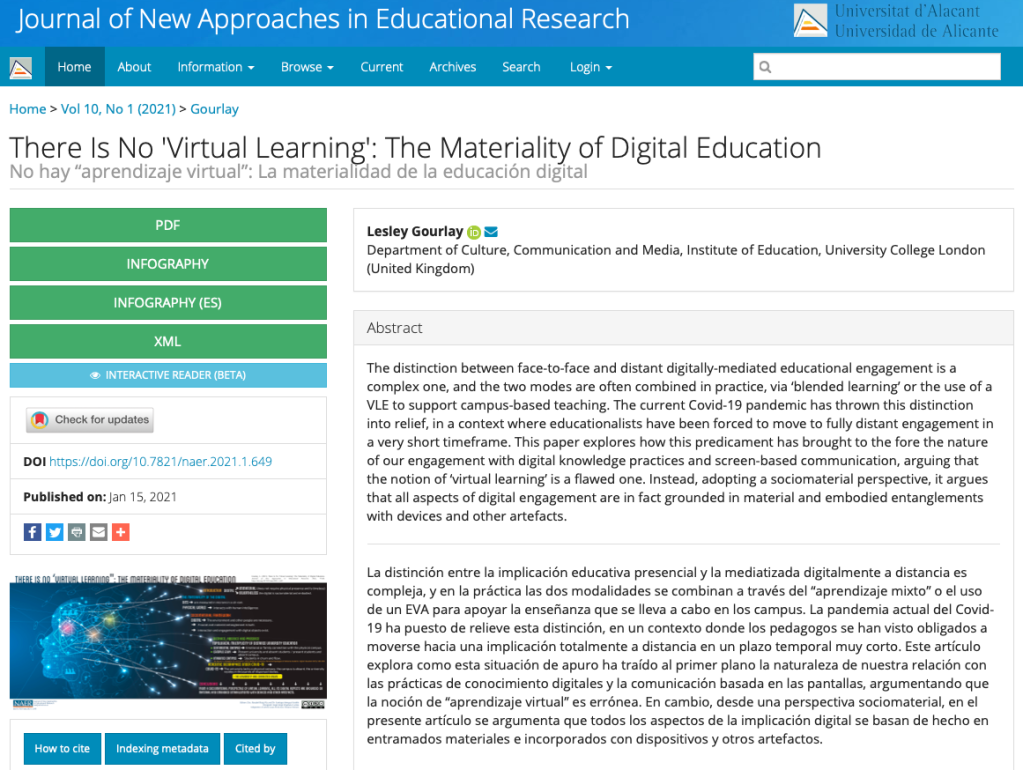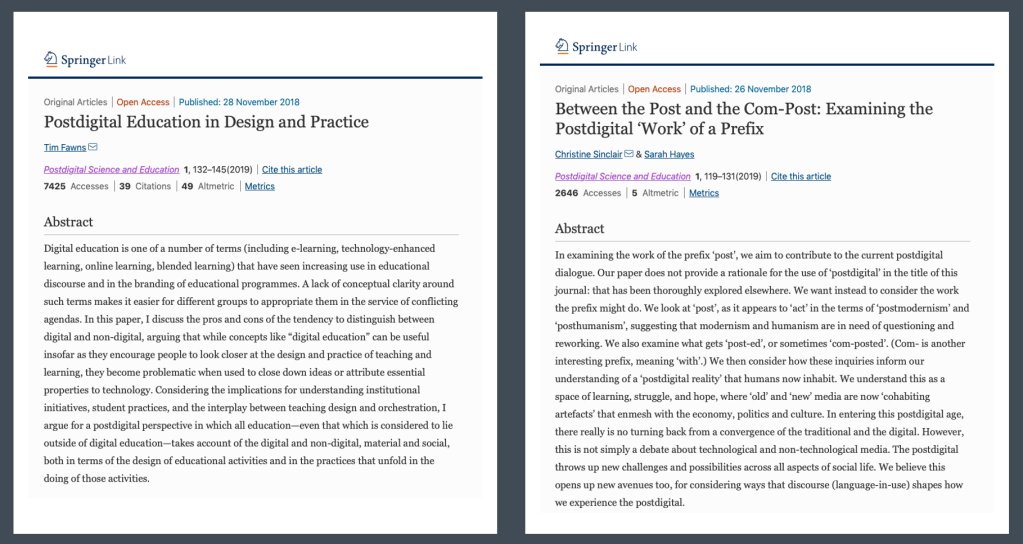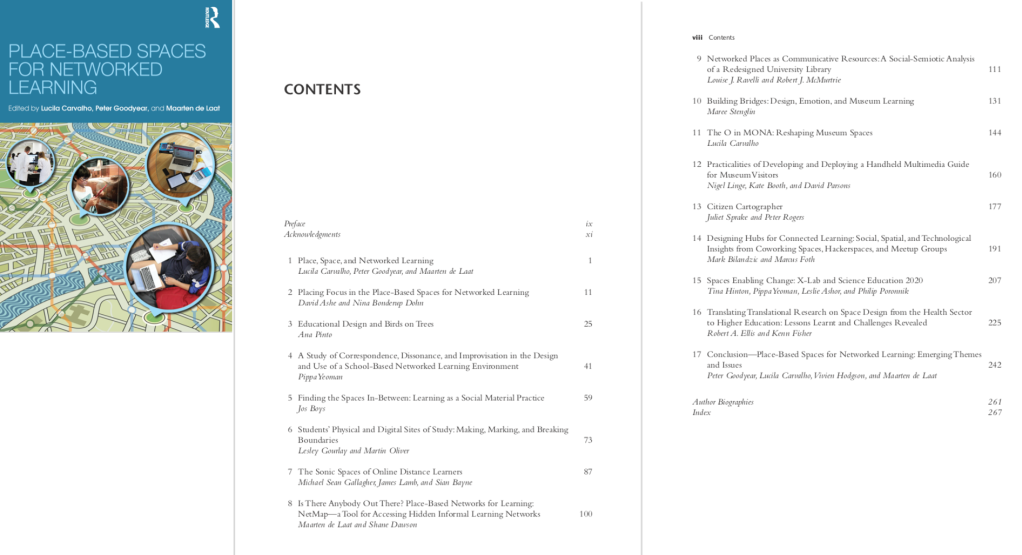In the process of drafting a recent paper ( NLEC 2020 “Networked learning: inviting redefinition” ) I suggested to co-authors that it might be an opportune moment to revive Ivan Illich’s concept of “tools for conviviality” (Illich 1973).
To be honest, we were stuck – we were facing a conundrum about how to refer to technology as part of the definition of Networked Learning.
The “customary definition” of Networked Learning runs as follows:
We define networked learning as: learning in which information and communications technology (ICT) is used to promote connections: between one learner and other learners; between learners and tutors; between a learning community and its learning resources. (Goodyear, Banks, Hodgson & McConnell, 2004, p1, original emphasis)
The first formulation of this definition is found in a research proposal we submitted in 1998.
We define ‘networked learning’ as learning in which C&IT is used to promote connections: between one learner and other learners, between learners and tutors; between a learning community and its learning resources. (Goodyear, Hodgson & Steeples, 1998, p2, original emphasis)
At the time, ‘C&IT’ (Communication and Information Technology) was the preferred acronym used by the funding body to whom we were bidding (the UK’s Joint Information Systems Committee – Jisc). Our proposal was a response to a call from Jisc for R&D projects addressing three aspects of what Jisc had labelled ‘Networked Learning’. The definition we wrote into our proposal was a deliberate strategy to insert into Jisc’s conception of ‘Networked Learning’ the kinds of human, social and community interactions in which we were interested, and which we particularly valued. The text we wrote into our proposal, immediately after the words above, helps establish this point.
Some of the richest examples of networked learning involve interaction with on-line materials and with other people. But use of on-line materials is not a sufficient characteristic to define networked learning. (Goodyear, Hodgson & Steeples, 1998, p2, original emphasis)
In the circumstances – late 1990s, UK Higher Education – it was quite likely that Jisc would fund proposals that focussed only on individual use of online learning materials (given the interest in personalised learning and more efficient “delivery” of education). We were keen to create other opportunities: a more ambitious conception of what was possible and worthwhile. We weren’t introducing the term “Networked Learning” – we were expanding what it meant and beginning to shift the core of its meaning. (There’s more on this history, if you are interested, in the first two chapters of the The Architecture of Productive Learning Networks .
Wind forward to 2020, and we find ourselves trying to construct a better definition – or at least a better concise description – of Networked Learning. The reasons for this are in the NLEC paper.
We struggle with an appropriate way of talking about what had previously been referred to as “C&IT” or “ICT”. One complicating factor is that none of us wants to say that the use of contemporary digital technologies is a necessaryfeature of Networked Learning – for at least two reasons. Firstly, in the 20 years or so since the definition was first written, use of “ICT” has moved from esoteric to everyday. Secondly, we’ve become much more conscious of hybridity – no longer wanting to make sharp distinctions between “digital” and “analogue” or (heaven forfend) “virtual” and “real”. Rather, the tools and infrastructures used by people in learning and other activities are better understood as assemblages or networks of people and things: material, digital and hybrid. This is well explained in a number of places. See, for instance, Chris Jones’s Networked Learning book (Jones, 2015) or papers by Fawns (2019) and Carvalho & Yeoman (2018).
Tim Fawns, for example, argues for
a postdigital perspective in which all education—even that which is considered to lie outside of digital education— takes account of the digital and non-digital, material and social, both in terms of the design of educational activities and in the practices that unfold in the doing of those activities. (Fawns, 2019, p132)
One of the strongest motives for revising the Networked Learning definition was that the older “customary” version did not foreground the critical and emancipatory commitments that are found widely in the Networked Learning literature. In finding an alternative to “ICT” or “digital technologies” we remembered Illich and his “tools for conviviality”. Hence, the text in NLEC (2020) says:
Networked learning involves processes of collaborative, co-operative and collective inquiry, knowledge-creation and knowledgeable action, underpinned by trusting relationships, motivated by a sense of shared challenge and enabled by convivial technologies. Networked learning promotes connections: between people, between sites of learning and action, between ideas, resources and solutions, across time, space and media.
In settling on these words, we were conscious of the fact that “convivial” is used by Illich with a special meaning and that anyone looking up dictionary definitions might be misled into thinking that “tools for conviviality” are the stock-in-trade of people who organise parties – bottles of wine, plates of food, music systems and balloons. Illich himself was conscious of this linguistic issue – that his readers might associate the term with “tipsy jolliness”.
After many doubts, and against the advice of friends whom I respect, I have chosen “convivial” as a technical term to designate a modern society of responsibly limited tools. In part this choice was conditioned by the desire to continue a discourse which had started with its Spanish cognate. … I am aware that in English “convivial” now seeks the company of tipsy jollyness, which is distinct from that indicated by the OED and opposite to the austere meaning of modern “eutrapelia,” which I intend. By applying the term “convivial” to tools rather than to people, I hope to forestall confusion. (Illich, 1973)
Illich uses the term ‘tool’ broadly, to include
“…simple hardware such as drills, pots, syringes, brooms, building elements, or motors, and not just large machines like cars or power stations [but also] productive institutions such as factories that produce tangible commodities like corn flakes or electric current, and productive systems for intangible commodities such as those which produce “education,” “health,” “knowledge,” or “decisions.” I use this term because it allows me to subsume into one category all rationally designed devices, be they artifacts or rules, codes or operators… School curricula or marriage laws are no less purposely shaped social devices than road networks.”
Illich explained the value of convivial tools in contrast to those provided by a centrally or hierarchically managed industrial society: one in which people are obedient workers and consumers.
Convivial tools are those which give each person who uses them the greatest opportunity to enrich the environment with the fruits of his or her vision. Industrial tools deny this possibility to those who use them and they allow their designers to determine the meaning and expectations of others. Most tools today cannot be used in a convivial fashion (Illich, 1973)
People need not only to obtain things, they need above all the freedom to make things among which they can live, to give shape to them according to their own tastes, and to put them to use in caring for and about others. Prisoners in rich countries often have access to more things and services than members of their families, but they have no say in how things are to be made and cannot decide what to do with them. Their punishment consists in being deprived of what I shall call “conviviality.” They are degraded to the status of mere consumers. (Illich, 1973)
He drew firm connections between conviviality and justice:
In an age of scientific technology, the convivial structure of tools is a necessity for survival in full justice which is both distributive and participatory. … Rationally designed convivial tools have become the basis for participatory justice (Illich, 1973)
In the NLEC 2020 paper we make connections to more recent work that is capturing the imagination of many people who are deeply concerned about contemporary challenges of climate change, sustainability, poverty and social justice, but who are uncertain about how to act. These feel, to me, to be close to the spirit of Illich on conviviality, and concerned with tools for joint inquiry and action. See especially Manzini (2015), Raworth (2017), Cottam (2019) and Krznaric (2020).
The connections to Networked Learning are most apparent in situations where people come together to both (a) analyse and understand a problematic situation and (b) decide what action to take together, and take it.
(a) is the homeground for people working in a critical tradition. If I wanted to be provocative, I might say that some people working in a critical tradition offer no tools for (b) – they write as if it is enough to name a problem and its causes. Planning and sustaining complex action in the world needs more than this.
Consider “expansive learning”. The following is taken from Engeström. Other examples where people come together to design processes of inquiry and action can be found in Chapter 19 of Markauskaite & Goodyear (2017).
“An ideal-typical sequence of epistemic actions in an expansive learning process can be condensed as follows.
The first action is that of questioning, criticizing or rejecting some aspects of the accepted practice and existing wisdom. For the sake of simplicity, this action is called questioning.
The second action is that of analyzing the situation. Analysis involves mental, discursive or practical transformation of the situation in order to find out causes or explanatory mechanisms. Analysis evokes “why?” questions and explanatory principles. One type of analysis is historical-genetic; it seeks to explain the situation by tracing its origins and evolution. Another type of analysis is actual-empirical; it seeks to explain the situation by constructing a picture of its inner systemic relations.
The third action is that of modeling the newly found explanatory relationship in some publicly observable and transmittable medium. This means constructing an explicit, simplified model of the new idea that explains and offers a solution to the problematic situation.
The fourth action is that of examining the model, running, operating and experimenting on it in order to fully grasp its dynamics, potentials and limitations.
The fifth action is that of implementing the model by means of practical applications, enrichments, and conceptual extensions.
The sixth and seventh actions are those of reflecting on and evaluating the process and consolidating its outcomes into a new stable form of practice.
Together these actions form an open-ended expansive cycle. In practice, the learning actions do not follow one another in a neat order. There are loops of returning and repeating some actions, as well as gaps of omitting or stepping over some action.” (Engeström, 2020, p37)
Most of Engeström’s examples arise from locally-situated work in “Change Laboratories”. For geographically dispersed communities committed to joint inquiry and action, Networked Learning offers some convivial tools.
In a recent Twitter exchange, Marianne Riis asked for some pointers to publications in the Networked Learning literature reporting use of “convivial tools”. (She and her colleague Anna Brodersen were working on a revision of the paper they presented at the 2020 Networked Learning Conference: “Development of a Pedagogical Design Matrix for ICT-based Boundary Crossing in Dual VET”. You can find it in the proceedings here.)
This is a very fair question, but it is not easily answered. One reason is that many of us would have to admit that we have/had begun to forget about Illich.
He visited my university and gave a talk in the mid 1970s. At the time, I found many of his ideas captivating. (I went to university to learn about environmental science and development studies and I became very interested in ideas about “appropriate technology” – the “small is beautiful” paradigm advanced by Ernst Schumacher and so on.) And I guess that as I immersed myself in the areas where technology and education overlap, I found myself thinking in ways influenced by Illich and others, without necessarily making direct connections. (I wrote a chapter on “convivial learning environments” for a book on learning and affect technologies about 10 years ago. My inaugural professorial lecture at Sydney University (2004) also drew on Illich, conviviality and learning spaces.)
So … how best to answer the question posed by Marianne and Anna?
1) Take a look at some of Petar Jandrić’s writing on Illich, conviviality, deschooling and the internet (e.g. Jandrić 2014).
2) And also some of the writing in the NL community on Illich’s notion of “learning webs” which was picked up by Christopher Alexander (“Pattern 18: Network of Learning”).
3) And then I would suggest some of the chapters in Part 2 of the Carvalho & Goodyear (2014) APLN collection – in which we chose to focus on networks that were consciously engaged in various forms of social action.
We mention Illich on the first page, where we set up Networked Learning, in part, by framing formal education as an aberration. But after that we neglect to mention him at all.
Looking across the history of our species, one sees much more experience of learning from networks of family, friends and acquaintances than of learning in formally constituted educational institutions, such as schools and universities. Indeed, some would argue that schools, colleges and modern universities will turn out to be a short-lived aberration – that they are suspect inventions that seemed to serve the needs of rapidly urbanizing and industrializing populations, but that soon turned out to be expensive and ineffective ways of meeting human needs (Illich 1973, Illich and Verne 1976,Varbelow and Griffith 2012). (Goodyear & Carvalho, 2014, p3).
However, I think it can be argued that a number of the chapters in Part 2 of APLN portray networks of people using technologies in a convivial manner. Other examples that spring quickly to mind come from the teaching of Viv Hodgson, Dave McConnell, Michael Reynolds and others on the MA in Management Learning at Lancaster – approaches and underpinning values that are reflected in their various contributions to the NL literature. (See for example Hodgson & McConnell, 2019.)
As a closing point, it should be clear by now that to label a tool or technology “convivial” is to speak mainly about how it is being used, and for what kinds of purpose. It is not saying much about what one might call the intrinsic or inherent properties of the tool. Illich implies that some tools are hard to use in convivial ways.
There’s an interesting line to explore here, concerning convivial technologies and the distinctions made in the instrumental genesis literature between the properties of a tool and the schemes for its use. (See, for instance, Rabardel & Beguin, 2005; Lonchamp, 2012; Ritella & Hakkarainen, 2012; Carvalho et al., 2019.)
References
Alexander, C., Ishikawa, S., Silverstein, M., Jacobson, M., Fiksdahl-King, I., & Angel, S. (1977). A pattern language: towns, buildings, construction. New York: Oxford University Press.
Carvalho, L., & Goodyear, P. (Eds.). (2014). The architecture of productive learning networks. New York: Routledge.
Carvalho, L., Martinez-Maldonado, R., & Goodyear, P. (2019). Instrumental genesis in the design studio. International Journal of Computer Supported Collaborative Learning, 14, 77-107. doi:https://doi.org/10.1007/s11412-019-09294-2
Carvalho, L., & Yeoman, P. (2018). Framing learning entanglement in innovative learning spaces: connecting theory, design and practice. British Educational Research Journal, 44(6), 1120–1137. doi:doi:10.1002/berj.3483
Cottam, H. (2019). Radical Help: How we can remake the relationships between us and revolutionise the welfare state: Little Brown.
Engeström, Y. (2020). Ascending from the abstract to the concrete as a principle of expansive learning. Psychological Science and Education, 25(5), 31-43.
Fawns, T. (2019). Postdigital education in design and practice. Postdigital Science and Education, 1, 132-145.
Goodyear, P. (2011) Affect, technology and convivial learning environments, in Calvo, R., & D’Mello, S. (Eds.). (2011). New perspectives on affect and learning technologies. Berlin: Springer.
Goodyear, P., & Carvalho, L. (2014). Networked learning and learning networks. In L. Carvalho & P. Goodyear (Eds.), The architecture of productive learning networks. New York: Routledge.
Goodyear, P., Banks, S., Hodgson, V., & McConnell, D. (2004). Research on networked learning: aims and approaches. Chapter 1 In P. Goodyear, S. Banks, V. Hodgson, & D. McConnell (Eds.), Advances in research on networked learning. Dordrecht: Kluwer Academic Publishers.
Goodyear, P., Hodgson, V., & Steeples, C. (1998). Student experiences of networked learning in higher education. Research proposal to Jisc: Lancaster
Hodgson, V., & McConnell, D. (2019). Networked learning and postdigital education. Postdigital Science and Education, 1(1), 43–64. https://doi.org/10.1007/s42438-018-0029-0.
Illich, I. (1973). Tools for conviviality. London: Marion Boyars.
Jandrić, P. (2014). Deschooling Virtuality. Open Review of Educational Research, 1(1), 84-98. doi:10.1080/23265507.2014.965193
Jones, C. R. (2015). Networked Learning: An educational paradigm for the age of digital networks. Dordrecht: Springer.
Lonchamp, J. (2012). An instrumental perspective on CSCL systems. International Journal of Computer-Supported Collaborative Learning, 7(2), 211-237. doi:10.1007/s11412-012-9141-4
Krznaric, R. (2020). The good ancestor: how to think long term in a short-term world. London: WH Allen.
Manzini, E. (2015). Design, when everybody designs: an introduction to design for social innovation. Cambridge MA: MIT Press.
Markauskaite, L., & Goodyear, P. (2017). Epistemic fluency and professional education: innovation, knowledgeable action and actionable knowledge. Dordrecht: Springer.
Networked Learning Editorial Collective. (2020). Networked Learning: Inviting Redefinition. Postdigital Science and Education. doi:10.1007/s42438-020-00167-8
Rabardel, P., & Beguin, P. (2005). Instrument mediated activity: from subject development to anthropocentric design. Theoretical issues in ergonomic science, 6(5), 429-461.
Raworth, K. (2017). Doughnut economics: seven ways to think like a 21st century economist. London: Penguin Random House.
Riis, M & Brodersen, A (2020) Development of a Pedagogical Design Matrix for ICT-based Boundary Crossing in Dual VET, Proceedings for the Twelfth International Conference on Networked Learning 2020, Edited by: Hansen, S.B.; Hansen, J.J.; Dohn, N.B.; de Laat, M. & Ryberg, T. pp175-182.
Ritella, G., & Hakkarainen, K. (2012). Instrumental genesis in technology-mediated learning: From double stimulation to expansive knowledge practices. International Journal of Computer-Supported Collaborative Learning, 7(2), 239-258. doi:10.1007/s11412-012-9144-1
Schumacher, E. (1974). Small is beautiful: a study of economics as if people mattered. London: Abacus.








